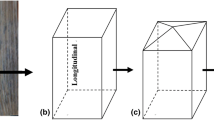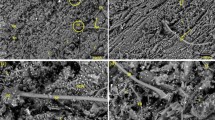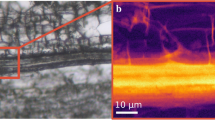Abstract
The visualization and the quantification of microscopic decay patterns are important for the study of the impact of wood-decay fungi in general, as well as for wood-decay fungi and microorganisms with possible applications in biotechnology. In the present work, a method was developed for the automated localization and quantification of microscopic cell wall elements (CWE) of Norway spruce wood such as bordered pits, intrinsic defects, hyphae or alterations induced by white-rot fungus Physisporinus vitreus using high-resolution X-ray computed tomographic microscopy. In addition to classical destructive wood anatomical methods such as light or laser scanning microscopy, this method allows for the first time to compute the properties (e.g., area, orientation and size distribution) of CWE of the tracheids in a sample. This is essential for modeling the influence of microscopic CWE on macroscopic properties such as wood strength and permeability.




Similar content being viewed by others
References
Deflorio G, Hein S, Fink S, Spiecker H, Schwarze FWMR (2005) The application of wood decay fungi to enhance annual ring detection in three diffuse-porous hardwoods. Dendrchronologia 22:123–130
Derome D, Griffa M, Koebel M, Carmeliet J (2010) Hysteretic swelling of wood at cellular scale probed by phase-contrast X-ray tomography. J Struct Biol 173(1):180–190
Dickson S, Kolesik P (1999) Visualisation of mycorrhizal fungal structures and quantification of their surface area and volume using laser scanning confocal microscopy. Mycorrhiza 9(4):205–213
Fuhr MJ, Schubert M, Schwarze FWMR, Herrmann HJ (2011) Modeling hyphal growth of the wood decay fungus Physisporinus vitreus. Fungal Biol. doi:10.1016/j.funbio.2011.06.017
Gonzalez RC, Woods RE, Eddins SL (2009) Digital image processing using MATLAB. Gatesmark Publishing, Tennessee
Illman B, Dowd B (1999) High resolution microtomography for density and spatial information about wood structures. In: Bonse U (ed) Proceedings of SPIE on developments in X-ray tomography II. Society of Photo-Optical Instrumentation Engineers, Washington, DC., pp 198–204
Lehringer C, Hillebrand K, Richter K, Arnold M, Schwarze F, Militz H (2010) Anatomy of bioincised Norway spruce wood. Int Biodeterioration Biodegradation 64(5):346–355
Mai C, Kües U, Militz H (2004) Biotechnology in the wood industry. Appl Microbiol Biotechnol 63(5):477–494
Majcherczyk A, Hüttermann A (1988) Bioremediation of wood treated with preservative using white-rot fungi. In: Bruce A, Palfreyman JW (eds) Forest products biotechnology. Taylor and Francis, London, pp 129–140
Mannes D, Marone F, Lehmann E, Stampanoni M, Niemz P (2010) Application areas of synchrotron radiation tomographic microscopy for wood research. Wood Sci Technol 44(1):67–84
Mayo SC, Chen F, Evans R (2010) Micron-scale 3D imaging of wood and plant microstructure using high-resolution X-ray phase-contrast microtomography. J Struct Biol 171(2):182–188
McGovern M, Senalik A, Chen G, Beall F, Reis H (2010) Detection and assessment of wood decay using x-ray computer tomography. In: Tomizuka M (ed) San Diego, CA, USA. SPIE, p 76474B
Messner K, Fackler K, Lamaipis P, Gindl W, Srebotnik E, Watanabe T (2002) Biotechnological wood modification. In: Proceedings of the international symposium on wood-based materials, part 2. Vienna University, Vienna, pp 45–49
Meyer F (1994) Topographic distance and watershed lines. Signal Proces 38(1):113–125
Munch B, Trtik P, Marone F, Stampanoni M (2009) Stripe and ring artifact removal with combined wavelet—Fourier filtering. Optics Express 17(10):8567–8591
Neuhäusler U, Schneider G, Ludwig W, Hambach D (2003) Phase contrast X-ray microscopy at 4 keV photon energy with 60 nm resolution. J Physique IV (Proceedings) 104:567–570
Otsu N (1979) A threshold selection method from gray-level histograms. IEEE Trans Sys Man Cyber 9:62–66
Schubert M, Schwarze FMWR (2010) Evaluation of the interspecific competitive ability of the bioincising fungus Physisporinus vitreus. J Basic Microbiol. doi:10.1002/jobm.201000176
Schubert M, Dengler V, Mourad S, Schwarze FWMR (2009) Determination of optimal growth parameters for the bioincising fungus Physisporinus vitreus by means of response surface methodology. J Appl Microbiol 106(5):1734–1742
Schubert M, Mourad S, Schwarze FWMR (2010) Radial basis function neural networks for modeling growth rates of the basidiomycetes Physisporinus vitreus and Neolentinus lepideus. Appl Microbiol Biotechnol 85:703–712
Schwarze F (2007) Wood decay under the microscope. Fungal Biol Rev 1:133–170
Schwarze FWMR (2008) Diagnosis and prognosis of the development of wood decay in urban trees. ENSPEC, Melbourne
Schwarze F (2009) Enhanced uptake of wood modification agents in ‘bioincised’ wood. In: The international research group on wood protection
Schwarze FWMR, Landmesser H (2000) Preferential degradation of pit membranes within tracheids by the basidiomycete Physisporinus vitreus. Holzforschung 54(5):461–462
Schwarze FWMR, Landmesser H, Zgraggen B, Heeb M (2006) Permeability changes in heartwood of Picea abies and Abies alba induced by incubation with Physisporinus vitreus. Holzforschung 60(4):450–454
Schwarze FWMR, Spycher M, Fink S (2008) Superior wood for violins—wood decay fungi as a substitute for cold climate. New Phytol 179(4):1095–1104
Spycher M, Schwarze FWMR, Steiger R (2008) Assessment of resonance wood quality by comparing its physical and histological properties. Wood Sci Technol 42(4):325–342
Stampanoni M, Groso A, Isenegger A, Mikuljan G, Chen Q, Bertrand A, Henein S, Betemps R, Frommherz U, Böhler P, Meister D, Lange M, Abela R (2006) Trends in synchrotron-based tomographic imaging: the SLS experience. Proc SPIE 6318(1):63180M
Stührk C, Fuhr M, Schubert M, Schwarze F (2010) Analyzing hyphal growth of the bioincising fungus Physisporinus vitreus with light-, confocal laser scanning- and, synchrotron X-ray tomographic microscopy. International Group on Wood Preservation, IRG 1020438. Biarritz, France, 2010. http://www.irg-wp.org/documents.htm
Trtik P, Dual J, Keunecke D, Mannes D, Niemz P, Stähli P, Kaestner A, Groso A, Stampanoni M (2007) 3D imaging of microstructure of spruce wood. J Struct Biol 159(1):46–55
Van den Bulcke J, Masschaele B, Dierick M, Acker JV, Stevens M, Hoorebeke LV (2008) Three-dimensional imaging and analysis of infested coated wood with X-ray submicron CT. Int Biodeterioration Biodegradation 61(3):278–286
Van den Bulcke J, Boone M, Van Acker J, Van Hoorebeke L (2009) Three-dimensional X-ray imaging and analysis of fungi on and in wood. Microsc Microanal 15(5):395–402
Acknowledgments
We acknowledge contributions and support of (in alphabetical order) Francois Gaignat, Hans Herrmann, Christian Lehringer, David Mannes, Peter Niemz, Pavel Trtik and Falk Wittel. We thank Masuru Abuku and Frederica Marone for their assistance during the measurements and Dominique Derome for supplying the climatic chamber. The authors express their gratitude to the Swiss National Foundation (SNF) No. 205321-121701 for its financial support.
Author information
Authors and Affiliations
Corresponding author
Rights and permissions
About this article
Cite this article
Fuhr, M.J., Stührk, C., Münch, B. et al. Automated quantification of the impact of the wood-decay fungus Physisporinus vitreus on the cell wall structure of Norway spruce by tomographic microscopy. Wood Sci Technol 46, 769–779 (2012). https://doi.org/10.1007/s00226-011-0442-y
Received:
Published:
Issue Date:
DOI: https://doi.org/10.1007/s00226-011-0442-y




